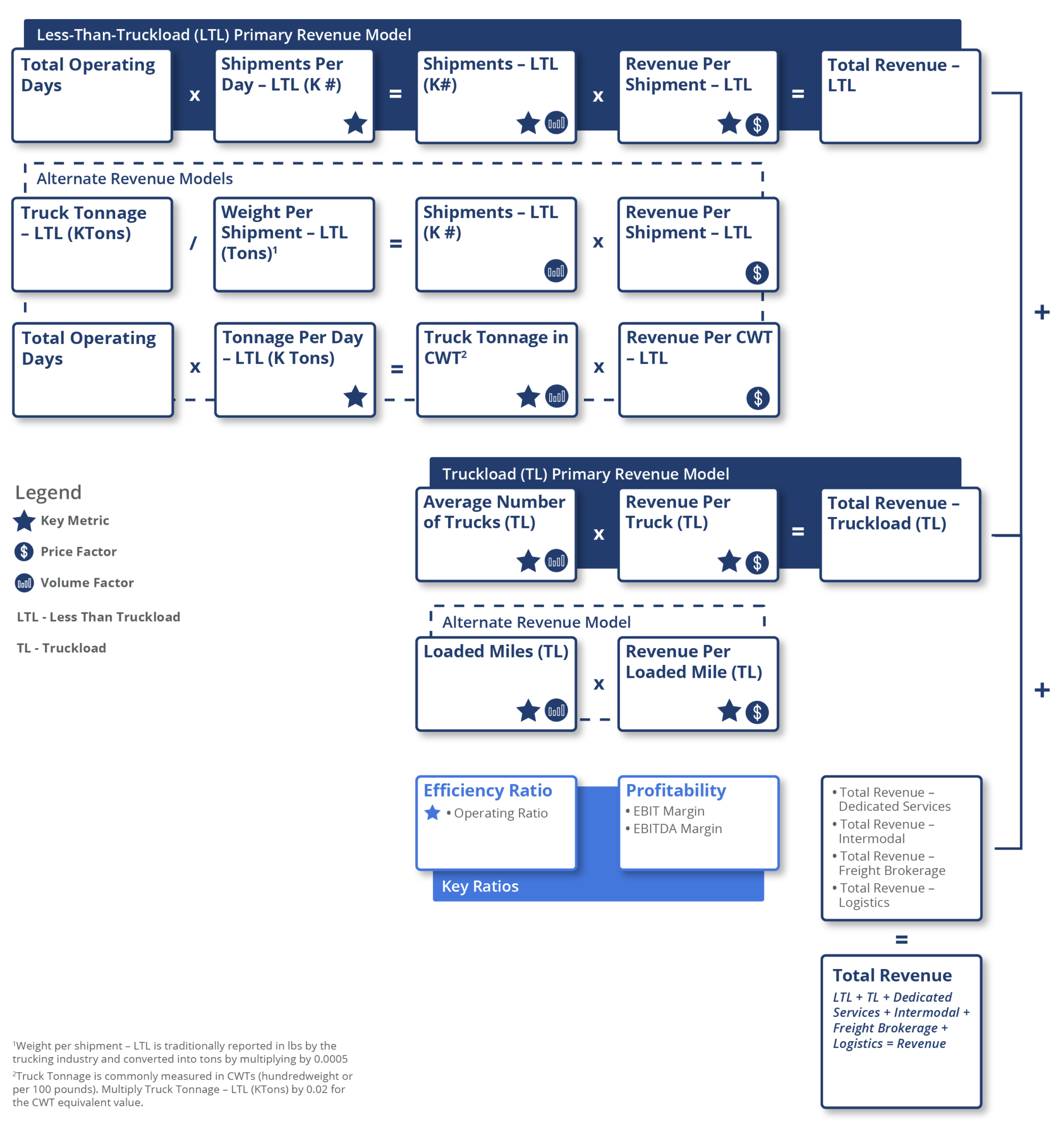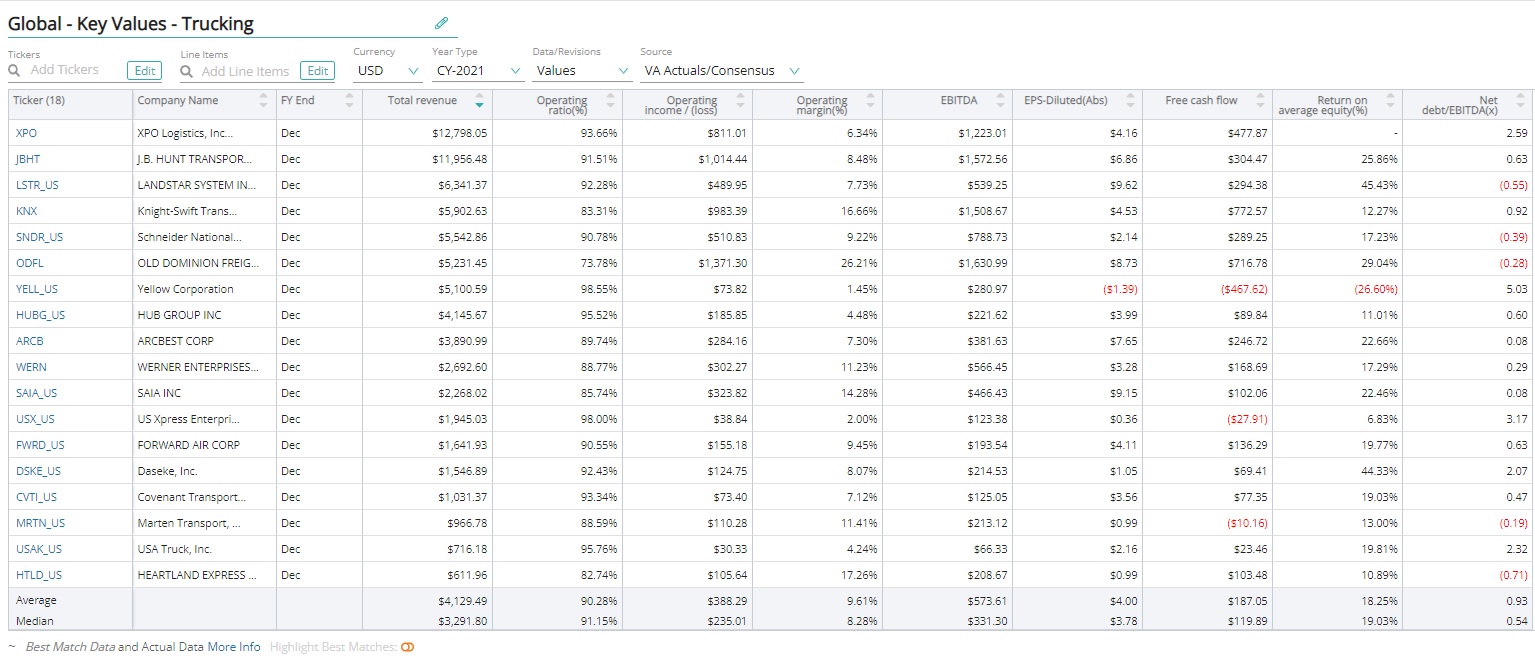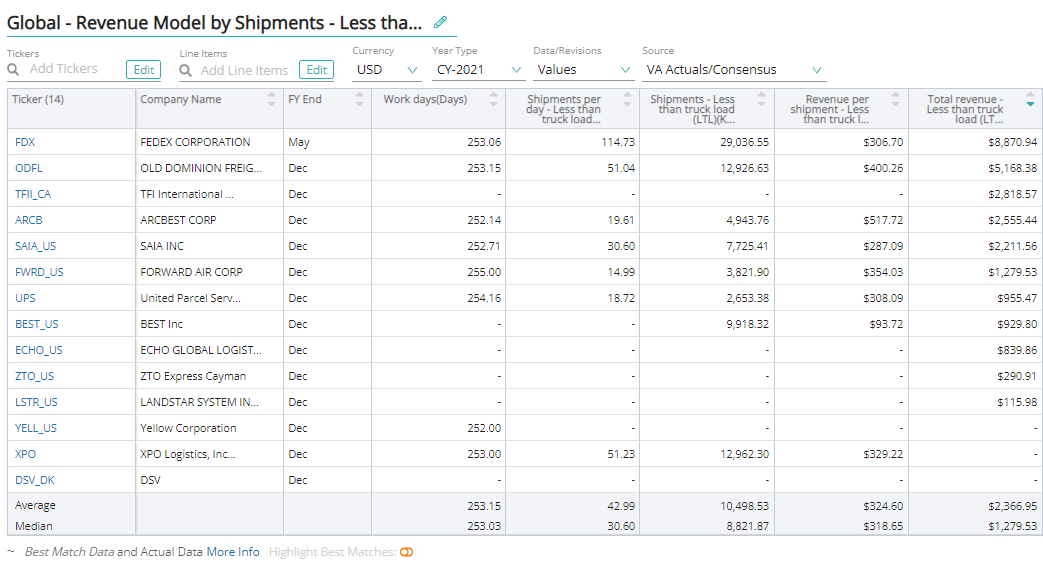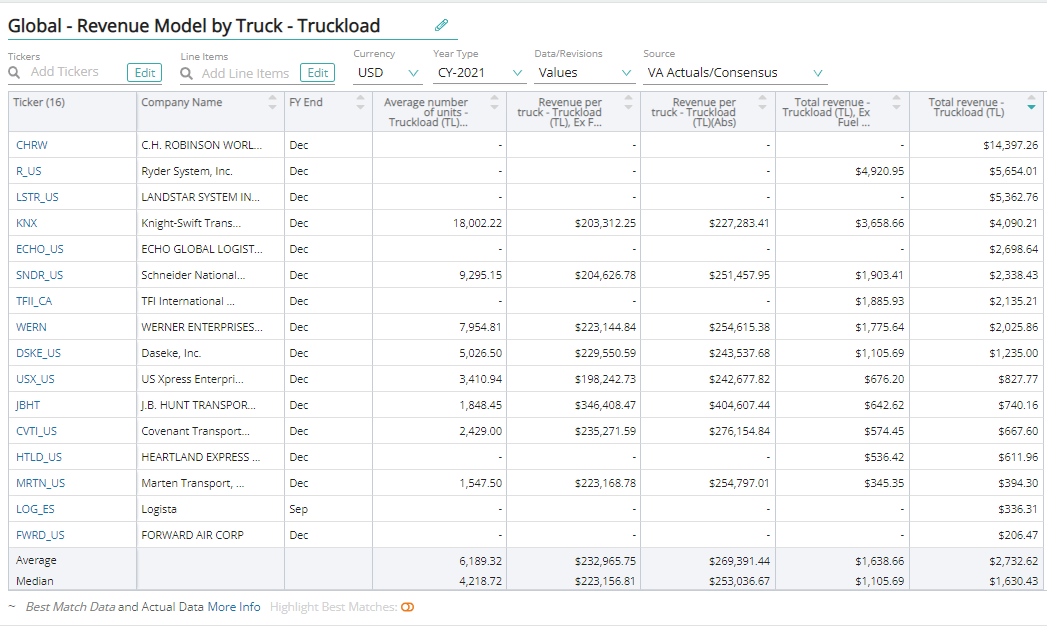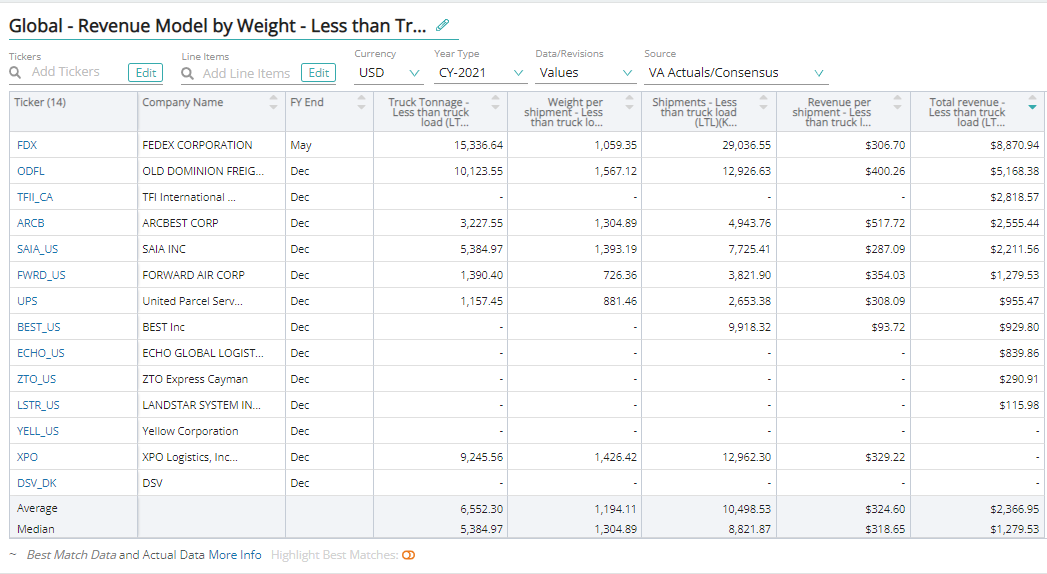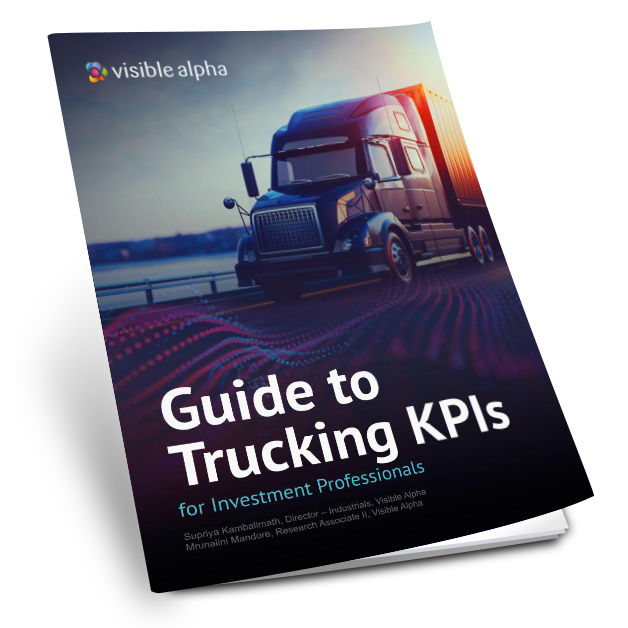Total miles refers to the overall miles traveled by truck including loaded and empty miles.
Trucking Business Model
The total revenue generated by companies in the trucking industry primarily comes from segments such as truckload (TL), less-than-truckload (LTL), dedicated services, intermodal services, freight brokerage, and logistics services.
Truckload (TL) shipping, also known as full truckload shipping, refers to the transportation of a large volume of shipment, typically enough to fill more than half or up to the full capacity of a 48 or 53 feet trailer. Full truckload shipping only carries cargo from a single customer or supplier, who has full and exclusive use of the trucking company’s trailer or truck. Companies charge for truckload services either based on a contract rate quota or a spot rate quota. A contract rate is a rate quota agreed upon by the freight provider in a contract, for a given period, usually one year. A spot rate quota is a one-time rate quota issued by a freight service provider, depending on the market conditions, to move the supplier’s product from point A to point B.
The total revenue generated from truckload services is derived by multiplying the volume metric – loaded miles by the pricing metric – revenue per loaded mile. The total revenue for truckload (TL) can be also computed by multiplying the average number of trucks by the revenue per truck.
Less-than-truckload (LTL) shipping refers to the transportation of small amounts of cargo from several different customers, to various delivery destinations. This type of shipping is affordable for small businesses or suppliers, as they can share the transportation costs with other businesses while using a third-party logistics (3PL) company for their cargo. Each supplier takes up a certain portion of space in the truck for their cargo and only pays according to the amount of cargo shipped and the distance traveled. LTL shipments often make several stops, thereby taking longer to reach the destination. Companies usually charge for LTL services based on spot rate quotas.
The total revenue generated from LTL services can be computed using two main approaches:
- By Shipments
In this approach, the total revenue from less-than-truckload (LTL) services is calculated by multiplying the total shipment by the pricing metric – revenue per shipment.Total shipments can be calculated by multiplying shipments per day by the total operating days. Total shipments can also be calculated by multiplying truck tonnage by weight per shipment. If the weight per shipment is available in pounds (lbs), it is converted to tons by multiplying it by 2000.
- By Truck Tonnage
In this approach, truck tonnage is calculated by multiplying the tonnage per day by total operating days. Truck tonnage is then multiplied by revenue per unit to arrive at the total revenue generated from less-than-truckload services (LTL). If the revenue per unit for LTL is in cwt, i.e., 100 pounds, it is converted into tons by multiplying it by 20.
Dedicated transportation services
Dedicated transportation services refer to dedicated transportation solutions provided by a trucking company to its customers/suppliers. Dedicated services are typically custom-designed depending on the customer’s requirements and include services such as trailers, combined equipment, fleet maintenance, drivers, and other additional services. Dedicated contract carriage offers significant benefits to companies such as increasing their competitive position, improving risk management, and integrating their transportation needs with their overall supply chain. Dedicated transportation services usually include a written, formal, longer-term agreement or contract that governs the services performed by the trucking company and the applicable rates.
Intermodal services
Intermodal transport refers to the movement of freight by two or more modes of transportation. By loading cargo in an intermodal container, the cargo can be moved seamlessly between multiple modes of transportation, without any handling of the cargo itself when changing modes. Trucking companies charge for intermodal services rendered primarily through contractual rate quotes with customers that are held static for a given period, usually one year.
Freight brokerage
A freight brokerage service provider acts as an intermediary between the shipper and the trucking company or the carrier. A freight broker provides the truck and trailer capacity suited for the requirements of the shipper along with others and also negotiates the freight rates for the customer/shipper.
Logistics
Logistics management is an integral part of delivering goods from suppliers to end-users or customers. It involves ensuring timely delivery of the cargo to the end-user, in the right quantity, in a good condition, and in the right place. Logistics managers are responsible for everything from packaging, storage, documentation, inventory management, freight damage, and other shipment-related services. Logistics management involves both internal and external distribution networks.
Fuel surcharge
Due to the volatile nature of fuel costs, trucking companies usually ensure a fuel surcharge revenue program is in place with most of their customers. Under this program, a majority of the fuel costs are billed and charged to the customers. These programs typically involve a specified computation based on the change in local, national, or regional fuel prices. Given the fluctuations in fuel prices, some of these programs have a time lag between when the fuel prices change and when this change is reflected in the revenue. It is not meaningful to compare the amount of fuel surcharge revenue or the change in fuel surcharge revenue between reporting periods to fuel and fuel taxes expense. Hence, companies separately report excluding fuel surcharge revenue as well.
Key performance indicators (KPIs) are the most important business metrics for a particular industry. When understanding market expectations for the trucking industry, whether at a company or industry level, here are some of the KPIs to consider:
Visible Alpha’s Standardized Industry Metrics
To understand market expectations for the Trucking industry, a key information source is sell-side analyst estimate and consensus forecast data. The buy-side, sell-side, and public companies leverage this type of data to conduct competitive analysis, a type of analysis conducted by professional analysts that involves comparing standardized metrics of one company with those of similar companies. Because companies report metrics differently – and sometimes report on different metrics altogether – standardizing the key metrics for each company can be a cumbersome process.
Visible Alpha Insights includes analyst data, company data, and industry data at a level of granularity unparalleled in the market. Our industry data – Standardized Industry Metrics – enables market participants to quantify and compare market expectations for companies across 150+ industries.
Data as of Januray 2023
Industry KPI Terms & Definitions
Total Miles
Total miles refers to the overall miles traveled by truck including loaded and empty miles.
Loaded Miles
Loaded miles are the miles driven by a truck, carrying the cargo to the desired location. These miles do not include empty return journeys of trailers (also known as dead-head miles).
Revenue Per Loaded Mile
Revenue per loaded mile can be calculated by dividing the total revenue – truckload (TL) by loaded miles – truckload (TL).
Revenue Per Loaded Mile, excluding Fuel Surcharge
Revenue per loaded mile, excluding fuel surcharge, can be calculated by dividing the total revenue – truckload (TL), excluding fuel surcharge by loaded miles – truckload (TL).
Average Number of Units, Trucks
The average number of units, trucks refers to the average number of trucks.
Revenue Per Truck
Revenue per truck is the revenue generated from each truck.
Revenue Per Truck, excluding Fuel Surcharge
Revenue per truck, excluding fuel surcharge, is revenue per truck – truckload (TL) excluding fuel surcharge, which is the fee that companies charge to cover the fluctuating cost of fuel.
Truck Tonnage
Truck tonnage is the total tonnage of freight, transported via trucks. It is calculated by multiplying the tonnage per day by the total operating days.
Tonnage Per Day
Tonnage per day is the tons of freight handled per day by a trucking company.
Total Operating Days
Total operating days are the total number of days during which a trucking company provides freight services.
Revenue Per Unit
Revenue per unit is the total revenue – less-than-truckload (LTL) divided by truck tonnage – less-than-truckload (LTL).
Weight Per Shipment
Weight per shipment is calculated by dividing shipments – less-than-truckload (LTL) by truck tonnage – less-than-truckload (LTL).
Shipments
Shipment refers to all the cargo being shipped together by a trucking company.
Shipments Per Day
Shipments per day are all the cargo being transported by a trucking company at the same time per day.
Revenue Per Shipment
Revenue per shipment is the total revenue of less-than-truckload (LTL) divided by shipments of less-than-truckload (LTL).
Intermodal
Intermodal is the use of two modes of freight, for example, truck and rail, to transport goods from a shipper to the consignee. The intermodal process usually begins with a container being moved by truck to a rail, then back to a truck to complete the process.
Dedicated Services
Dedicated transportation services are ideal for situations where the freight is moved on a consistent route and needs either a committed pool of specialized equipment or has distinct freight handling requirements.
Freight Brokerage
Freight brokerage is the revenue generated from a variable cost business that facilitates the trucking of cargo by procuring carriers through the use of proprietary technology. Freight brokerage is essentially another business that assists shippers with freight ready to haul by finding carriers who are qualified to haul the load.
Logistics
Logistics management involves getting products to customers on time, in the proper quantities, in good condition, and at the right price. This includes overseeing transportation, storage of materials, production, and inventory management. Logistics includes the packaging of products for storage and shipment.
Operating Ratio
The operating ratio is computed by dividing a trucking company’s total operating expense by its total revenue, for a given period. It is used to determine the operational efficiency of a trucking company.
Download this guide as an ebook today:
Guide to Trucking KPIs for Investment Professionals
This guide highlights the key performance indicators for the trucking industry and where investors should look to find an investment edge, including:
- Trucking Industry Business Model & Diagram
- Key Trucking Metrics PLUS Visible Alpha’s Standardized Industry Metrics
- Available Comp Tables
- Industry KPI Terms & Definitions

